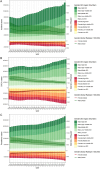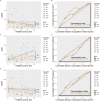Global burden and future trends of inguinal, femoral, and abdominal hernia in older adults: A systematic analysis from the Global Burden of Disease Study 2021
- PMID: 40478891
- PMCID: PMC12143580
- DOI: 10.1371/journal.pone.0323790
Global burden and future trends of inguinal, femoral, and abdominal hernia in older adults: A systematic analysis from the Global Burden of Disease Study 2021
Abstract
Objective: This study aims to comprehensively evaluate the global, regional, and national burden, trends, and health inequalities of inguinal, femoral, and abdominal hernias among older adults from 1990 to 2021, conduct predictive analyses, and provide insights to inform future public health strategies.
Methods: A secondary analysis was conducted using the Global Burden of Disease 2021, focusing on the temporal trends, health inequality, and predictive development of inguinal, femoral, and abdominal hernia burden among older adults.
Results: Globally, the number of incident cases of inguinal, femoral, and abdominal hernias among older adults continuously increased from 1990 to 2021, along with the decline in age-standardized rates, prevalence, and Disability-Adjusted Life Years (DALYs). Older males exhibited higher incidence rates, prevalence, and DALYs for hernias relative to females. In terms of the Socio-Demographic Index (SDI) from 1990 to 2021, the Age-Standardized Prevalence Rate (ASPR) and Age-Standardized Rate of Disability-Adjusted Life Years (ASDR) remained the highest in low-middle and low SDI regions, while the Age-Standardized Incidence Rate (ASIR) was the highest in high SDI regions. At the national level, 10 countries experienced a significant increase in ASDR and ASPR, and 15 countries in ASIR. Among these, the highest increase was observed for ASIR in China, ASPR in Georgia, and ASDR in American Samoa. The projections to the year 2035 indicate an increase in the incidence and prevalence of hernias, with older males remaining predominant. However, the DALY rate is expected a declining trend.
Conclusions: In spite of the progress in reducing the burden of inguinal, femoral, and abdominal hernias in older adults, the overall burden tends to rise. In particular, countries such as India, China, and Georgia are experiencing an increasing burden. It is crucial to implement targeted medical interventions, especially for older males in these regions.
Copyright: © 2025 Zhang et al. This is an open access article distributed under the terms of the Creative Commons Attribution License, which permits unrestricted use, distribution, and reproduction in any medium, provided the original author and source are credited.
Conflict of interest statement
The authors have declared that no competing interests exist.
Figures








Similar articles
-
Global pattern, trend and cross-country inequalities of inguinal, femoral, and abdominal hernia among individuals aged 60 and above from 1990 to 2021 and projections until 2040: a population-based study.Surg Endosc. 2025 Jul;39(7):4335-4344. doi: 10.1007/s00464-025-11810-5. Epub 2025 May 28. Surg Endosc. 2025. PMID: 40437076
-
Spatiotemporal trends in hernia disease burden and health workforce correlations in aging populations: a global analysis with projections to 2050.BMC Gastroenterol. 2025 Apr 25;25(1):296. doi: 10.1186/s12876-025-03916-w. BMC Gastroenterol. 2025. PMID: 40281398 Free PMC article.
-
Global, regional, and national burden of inguinal, femoral, and abdominal hernias: a systematic analysis of prevalence, incidence, deaths, and DALYs with projections to 2030.Int J Surg. 2024 Apr 1;110(4):1951-1967. doi: 10.1097/JS9.0000000000001071. Int J Surg. 2024. PMID: 38265437 Free PMC article.
-
Burden of inguinal, femoral, and abdominal hernias in India: A systematic analysis of prevalence, incidence, mortality, and DALYs from global burden of disease study 1990-2021 with projections to 2031.Hernia. 2025 May 3;29(1):158. doi: 10.1007/s10029-025-03343-6. Hernia. 2025. PMID: 40317332
-
Global, regional and national burden of knee osteoarthritis 1990-2021: A systematic analysis of the Global Burden of Disease study 2021.Arch Gerontol Geriatr. 2025 Sep;136:105867. doi: 10.1016/j.archger.2025.105867. Epub 2025 May 9. Arch Gerontol Geriatr. 2025. PMID: 40403596 Review.
Cited by
-
Modern Perspectives on Inguinal Hernia Repair: A Narrative Review on Surgical Techniques, Mesh Selection and Fixation Strategies.J Clin Med. 2025 Jul 9;14(14):4875. doi: 10.3390/jcm14144875. J Clin Med. 2025. PMID: 40725568 Free PMC article. Review.
References
-
- Ma Q, Jing W, Liu X, Liu J, Liu M, Chen J. The global, regional, and national burden and its trends of inguinal, femoral, and abdominal hernia from 1990 to 2019: findings from the 2019 Global Burden of Disease Study - a cross-sectional study. Int J Surg. 2023;109(3):333–42. doi: 10.1097/JS9.0000000000000217 - DOI - PMC - PubMed
MeSH terms
LinkOut - more resources
Full Text Sources

